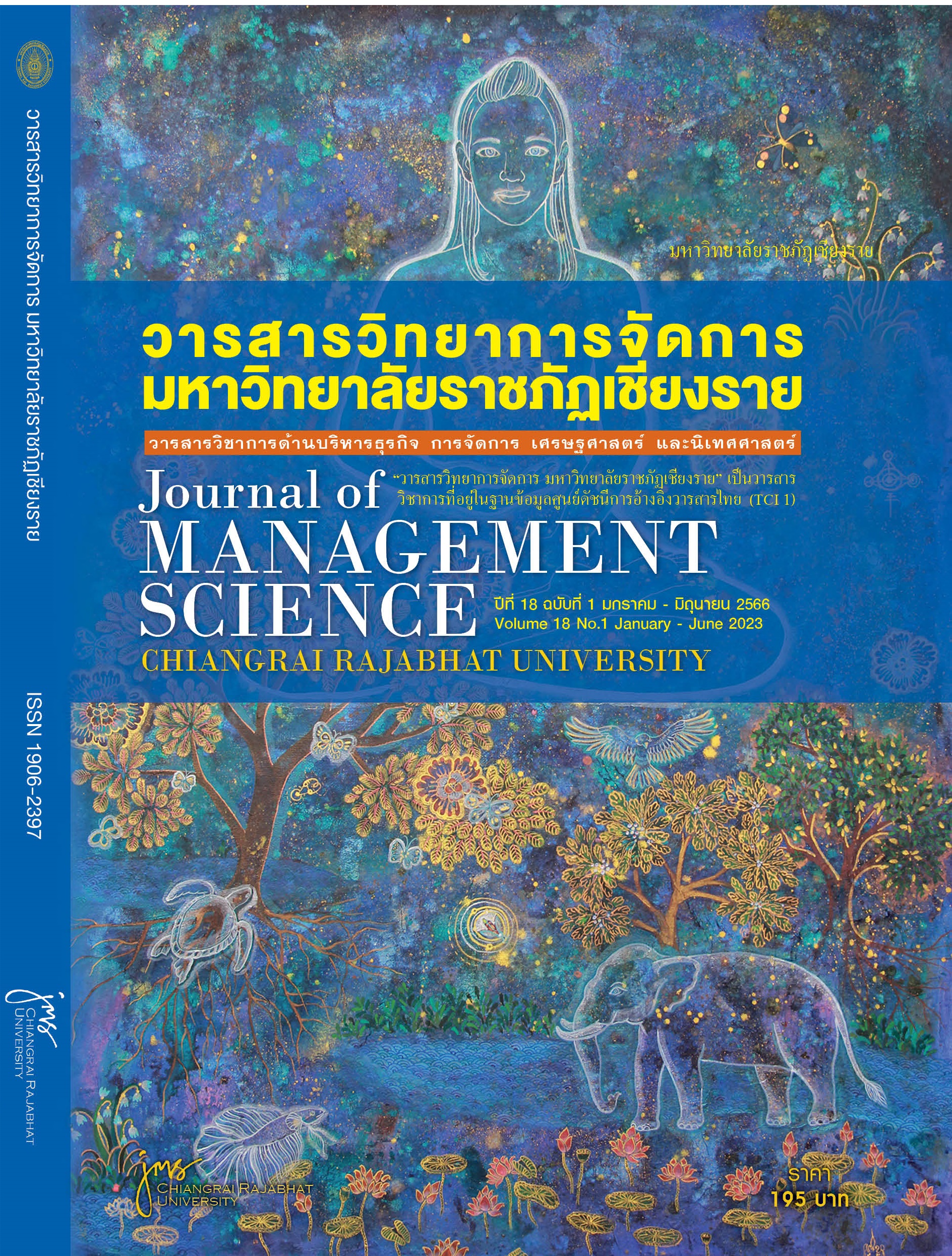The Development of Tourism Activity Standards in OTOP Nawatwiti Tourism Community Project to Connect Main Cities and Secondary Cities Tourist Routes: A Case of Ao Wat Mai Community, Nakhon Chaisri District, Nakhon Pathom Province
Main Article Content
Abstract
The objectives of this research were 1) to study the context of the community and tourism potential in the Ao Wat Mai community, Nakhon Chaisri District, Nakhon Pathom Province, 2) to study expectations towards tourism activities in the OTOP Nawatwiti Tourism Community Project, and 3) to develop tourism activity standards in the OTOP Nawatwiti Tourism Community Project to connect main cities and secondary cities tourist routes. The research utilized mixed methods research, with data collection tools including in-depth interviews for qualitative research with a primary data group consisting of 40 individuals who were representatives from the community, government, and private sectors who had lived or worked in the area for at least 10 years, and a survey using questionnaires for quantitative research with a sample group of 400 Thai tourists who had traveled to the Ao Wat Mai community. The statistical tools used for data analysis included percentage, mean, standard deviation, and data analysis for drawing conclusions. The results of this study indicated that 1) The Ao Wat Mai community utilized the tourism potential in the area to create tourism activities along the Route of Hundred Loves……Eat Delicious Food at Roi Ran Market, Visit the Legend of Luang Poh Somwong, such as tourism activities at Wat Klang Bang Phra, shopping for local products at the Roi Ran market at Wat Klang Bang Phra, and agritourism activities at Uncle Cherd's pomelo orchard. 2) The feedback on the creation of tourism activity standards found that tourists were highly satisfied with the local personnel and local interpreters (mean = 4.19, SD = 0.742), which was the highest ranking. 3) The tourism activity standards of the OTOP Nawatwiti Tourism Community Project consisted of six components: 1) Tourism personnel, 2) Tourism attractions and facilities, 3) OTOP products and food, 4) OTOP Nawatwiti Tourism Community Activities, and 5) Community tourism promotion
Article Details

This work is licensed under a Creative Commons Attribution-NonCommercial-NoDerivatives 4.0 International License.
Views and opinions expressed in the journal do not necessarily reflect those of the editors.
References
Anek Yaiin, Phrakhru Sangkharakchakkrit Puripanyo and Phra Komsan Charoenwongka. (2020). Innovatiive Ways of Good Communities: Extending Wisdom to Adding Economic Value. Journal of MCU Social Development. 6(2), 77-92. (in Thail)
Aswin Sangpikul. (2013). Research Methodology in Tourism and Hospitality. Bangkok: Dhurakij Pundit University. (in Thai)
Aumporn Linjaroen. (2011). Techniques for Analyzing Qualitative Data. Journal of Educational Measurement Mahasarakham University. 17(1), 17-29. (in Thai)
Bang Phra Subdistrict Administrative Organization. (2017). Strategy Plan of Bang Phra Subdistrict Administrative Organization (2017-2020). Retrieved March 8, 2021, from https://www.bangphralocal.go.th/post/. (in Thai)
Boonlert Jittangwattana. (2005). Sustainable Tourism Development. 1sted. Bangkok: first and Design. (in Thai)
Bussaba Sitikarn, Athitaya Pathan, Nanchaya Gateubol, Piyanuch Prangkham. (2018). Promotion of Local Wisdom in Community-based Tourism Management in Ethnic Communities in the Lanna Civilization Cluster. Jounal of Management Science Chiangrai Rajabhat University, 3(2), 170-192. (in Thai)
Community Development Department. (2018). Guideling for Tourism Community Project Management OTOP Nawatwithi. Bangkok : Community Development Department. (in Thai)
Designated Areas for Sustainable Tourism Administration (DASTA). (2015). Guideline for Community-based Tourism Management Standard Criteria. Bangkok : Designated Areas for Sustainable Tourism Administration (Public Organization). (in Thai)
Fongchan Luangchanduang, Waraporn Panyawadee. (2018). Development of Sustainable Creative Indicators for Community-Based Tourism. Electronic Journal of Open and Distance Innovative Learning. 8(1), 79-104. (in Thai)
Ministry of Tourism and Spots. (2021). Tourism Statistics 2020. . Retrieved May 2, 2022, from https://www.mots.go.th/news/category/630. (in Thai)
Ministry of Tourism and Sports. (2014). Guidelines for Assessment of Cultural Tourist Attractions Quality Standards. Bangkok : Ministry of Tourism and Sports. (in Thai)
Office of the National Economic and Social Development Council. (n.d.). Report on Economic Conditions in the Country in 2021. Retrieved May 2, 2022, from https://www.nesdc.go.th/ewt_news.php?nid=11555. (in Thai)
Pimrawee Rocharungsat. (2013). Community Tourism. 2nded. Bangkok: O.S.Printing House. (in Thai)
Photchana Suansri. (2003). Community based Tourism Handbook. 1sted. Bangkok: Tourism for Life and Nature Project. (in Thai)
Ranee Esichaikul. (2014). Niche Tourism Management. 1sted. Nonthaburi: Sukhothai Thammathirat Open University. (in Thai)
Richards and Wilson. (2000). Creative Tourism. ATLAS News 23} 16-20.
Sangha Information Center Region 14. (2021). Wat Klang Bang Phra. Retrieved October 15, 2021, from https://www.sangha14.org/index.php?url=temple&id=696. (in Thai)
Supang Chantawanich. (2010). Qualitative Research Methods. 18thed. Bangkok: Chulalongkorn University Printing House. (in Thai)
Suwimon Tirakanan. (2007). Creating Tool to Measure Variables in Social Science Research. 2nded. Bangkok: Chulalongkorn University Printinghouse. (in Thai)
Thanin Siljaru. (2005). Research and Analysis of Statistical Data with SPSS. Bangkok: V. Interprint. (in Thai).
Therdchai Choibamroong. (2021). Normalcy in New Normal, Thai Tourism in an Emergency Situation. 1sted. Bangkok: Superior Printinghouse. (in Thai)
Therdchai Choibamroong. (2009). The Role of Local Government Organizations in Sustainable Tourism Development based on Concept of Sufficiency Economy. Bangkok: Cabinet and Royal Gazette Publishing Office. (in Thai)
Uthumporn Rueangrit, Pakamas Chairatana. (2022). Creative Tourism Route Model Based on Cultural Wisdom of Ban Don Manao Tai Dam Ethnic Suphanburi Province. Journal of Liberal Art of Rajamangala University of Technology Suvarnabhumi, 40(1), 113-127. (in Thai)
Weerapon Thongma. (2016). Community Based Tourism: CBT for Developing Quality of Life Community in Forest Area. Retrieved March 11, 2021, from http://www.dnp.go.th/fca16/file/149xy4ghqzsh3j1. (in Thai)
Western Regional Rajabhat University Research Network. (2020). Creative Safety Gastronomy Tourism of Agricultural Community-base on Spatial Diversity in Western Region (Research Report). National Research Council of Thailand (NRCT). (in Thai)
Yamane. (1973). Statistics: on Introductory Analysis. New York: Harper & Row.


